Tea creation classes offer you a hands-on journey to blend your way to wellness. You'll learn to craft custom teas, understanding flavor profiles and therapeutic properties of ingredients. These classes foster creativity, promote mindfulness, and serve as relaxing social activities. You'll gain essential skills in measuring, brewing, and storing teas, while exploring popular herbal ingredients like chamomile, peppermint, and ginger. From crafting signature blends to mastering seasonal variations, you'll discover how to harness nature's remedies in your daily life. By developing your tea-blending expertise, you'll unveil a world of aromatic possibilities and lifelong benefits for your well-being.
Benefits of Tea Blending Classes
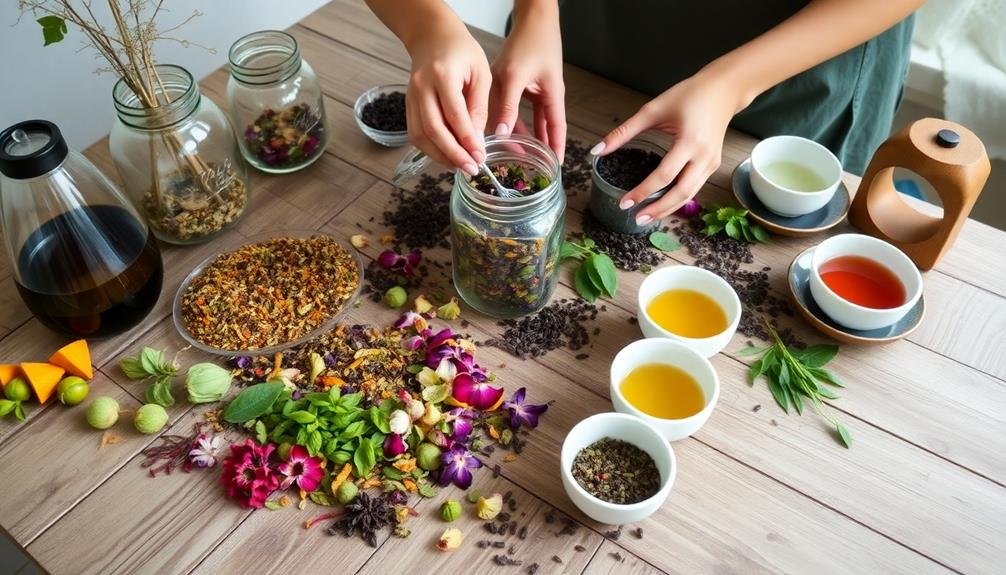
Through tea blending classes, you'll reveal a world of aromatic possibilities. These hands-on experiences offer more than just a chance to mix leaves; they're gateways to creativity, wellness, and sensory exploration.
You'll learn to identify and combine various tea types, herbs, and botanicals, developing a keen understanding of flavor profiles and their interactions.
As you master the art of blending, you'll gain the ability to craft custom teas tailored to your taste preferences and health goals. This skill empowers you to create caffeine-free options, immune-boosting blends, or calming evening infusions.
You'll also discover the therapeutic properties of different ingredients, allowing you to harness nature's remedies in your daily cup.
Tea blending classes foster mindfulness and relaxation, providing a respite from daily stresses. They're excellent social activities, too, offering opportunities to connect with like-minded enthusiasts.
You'll enhance your palate, learning to discern subtle flavor notes and aromas. This newfound knowledge will transform your tea-drinking experience, making each sip more meaningful and enjoyable.
Ultimately, these classes equip you with a lifelong skill that bridges tradition, creativity, and well-being.
Essential Tools for Tea Creation
To create your own tea blends, you'll need some essential tools.
Start with accurate measuring and weighing equipment, such as digital scales and measuring spoons, to guarantee consistency in your recipes.
Additionally, invest in proper tea storage containers to keep your ingredients and finished blends fresh and flavorful.
Measuring and Weighing Equipment
Precision is key when crafting the perfect cup of tea. To achieve this, you'll need reliable measuring and weighing equipment. Start with a digital scale that measures in grams and ounces, accurate to 0.1g. This will guarantee you're using the right amount of tea leaves for each blend.
Invest in a set of measuring spoons, including 1/4 teaspoon, 1/2 teaspoon, 1 teaspoon, and 1 tablespoon sizes. These are essential for adding smaller quantities of herbs and spices to your blends. For liquid ingredients, use graduated measuring cups with clear markings.
Don't forget about temperature control. A digital thermometer will help you heat water to the ideal temperature for different tea types. Green teas, for example, require lower temperatures than black teas.
To measure steeping time accurately, use a timer with a clear display and alarm. This can be a simple kitchen timer or a specialized tea timer.
Lastly, consider getting a hydrometer to measure the density of your liquid ingredients. This tool is particularly useful when creating kombucha or other fermented tea drinks, guaranteeing consistency in your brews.
Tea Storage Containers
Proper storage is essential for maintaining your tea's quality and freshness. When selecting tea storage containers, opt for airtight options that protect your blends from light, moisture, and odors. Glass jars with tight-fitting lids are excellent choices, allowing you to see the contents while keeping them sealed.
For light-sensitive teas, consider using opaque ceramic canisters or tins with double lids. Look for containers with a wide mouth for easy access when measuring ingredients. If you're creating multiple blends, invest in a set of uniform containers to keep your workspace organized. Label each container clearly with the tea's name and blending date.
For larger quantities, food-grade stainless steel canisters offer durability and excellent protection. If you're storing delicate teas like green or white varieties, choose containers with a second inner lid to minimize air exposure.
Don't forget about portability. Small tins or resealable pouches are perfect for sharing your creations or taking them on the go.
Popular Herbal Ingredients

When you're creating herbal teas, you'll find certain ingredients are particularly popular due to their health benefits.
You can use chamomile for its calming properties, perfect for a relaxing evening blend.
Peppermint is excellent for aiding digestion, while ginger offers powerful anti-inflammatory effects that can be incorporated into various tea recipes.
Chamomile for Relaxation
Chamomile, a gentle yet powerful herb, stands out as a popular choice for relaxation in tea blends. Its delicate, apple-like aroma and mild, sweet flavor make it a soothing addition to any calming tea mixture.
When you're creating your own relaxation blend, consider incorporating chamomile as a key ingredient to promote restfulness and ease tension.
In your tea creation class, you'll learn how to effectively use chamomile to maximize its relaxing properties. You'll discover that this versatile herb pairs well with other calming ingredients like lavender, lemon balm, and passionflower.
By experimenting with different combinations, you can create a personalized blend that caters to your specific relaxation needs.
To fully appreciate chamomile's benefits in your tea blends:
- Steep chamomile flowers for 5-7 minutes to extract their full flavor and therapeutic compounds
- Try combining chamomile with honey for a natural sweetness that complements its mild taste
- Experiment with different ratios of chamomile to other herbs to find your perfect balance
As you explore chamomile's potential in your tea creations, you'll develop a deeper understanding of its calming effects and how to harness them in your custom blends.
Peppermint's Digestive Benefits
A rejuvenating burst of coolness, peppermint is renowned for its digestive benefits in herbal tea blends. You'll find this versatile herb can soothe an upset stomach, reduce bloating, and alleviate nausea. Its natural menthol content helps relax the muscles of your gastrointestinal tract, easing discomfort and promoting healthy digestion.
When you're crafting your own tea blends, consider incorporating peppermint to aid in relieving indigestion and reducing stomach acid. It's particularly effective after heavy meals or when you're experiencing digestive distress. You can pair peppermint with other herbs like ginger or fennel to enhance its digestive properties and create a more complex flavor profile.
Peppermint tea isn't just for settling your stomach; it can also help with headaches and mental clarity. The herb's invigorating aroma can stimulate your senses and improve focus.
When brewing peppermint tea, steep the leaves for 5-7 minutes in hot water to extract maximum benefits. Remember, while peppermint is generally safe, it may interact with certain medications or exacerbate acid reflux in some individuals. Always consult with a healthcare professional if you have concerns about adding new herbs to your diet.
Ginger's Anti-Inflammatory Properties
Countless tea enthusiasts turn to ginger for its potent anti-inflammatory properties. This spicy root has been used for centuries in traditional medicine to reduce inflammation and alleviate various ailments. When you're creating your own tea blends, incorporating ginger can provide numerous health benefits.
Ginger contains compounds called gingerols, which are responsible for its anti-inflammatory effects. These powerful substances can help reduce muscle pain, arthritis symptoms, and even menstrual cramps. By adding ginger to your tea, you're not only enhancing its flavor but also boosting its therapeutic potential.
To make the most of ginger's anti-inflammatory properties in your tea creations:
- Use fresh ginger root for maximum potency
- Combine ginger with turmeric for a synergistic effect
- Pair ginger with lemon to increase antioxidant absorption
When brewing ginger tea, steep it for at least 10 minutes to extract its beneficial compounds fully. You can also experiment with different forms of ginger, such as dried or powdered, to find your preferred taste and strength.
Crafting Your Signature Blend
Equipped with knowledge of tea varieties and flavor profiles, you're ready to commence on the exciting journey of crafting your signature blend. Start by selecting a base tea, such as black, green, or white, which will form the foundation of your creation. Then, consider complementary flavors that'll enhance the base without overpowering it.
Experiment with different ratios of ingredients to achieve the perfect balance. Don't be afraid to mix unconventional elements – you might discover a surprising combination that delights your palate. Keep detailed notes of your experiments to replicate successful blends.
| Base Tea | Complementary Flavors | Enhancers |
|---|---|---|
| Black | Citrus, Spices | Rose Petals |
| Green | Jasmine, Mint | Lemongrass |
| White | Berries, Peach | Lavender |
As you refine your blend, consider the visual appeal and aroma. Dried flowers, citrus peels, or spices can add both flavor and aesthetic charm. Remember, your signature blend should reflect your personal taste and style. With practice and patience, you'll create a unique tea that's truly your own.
Therapeutic Properties of Teas
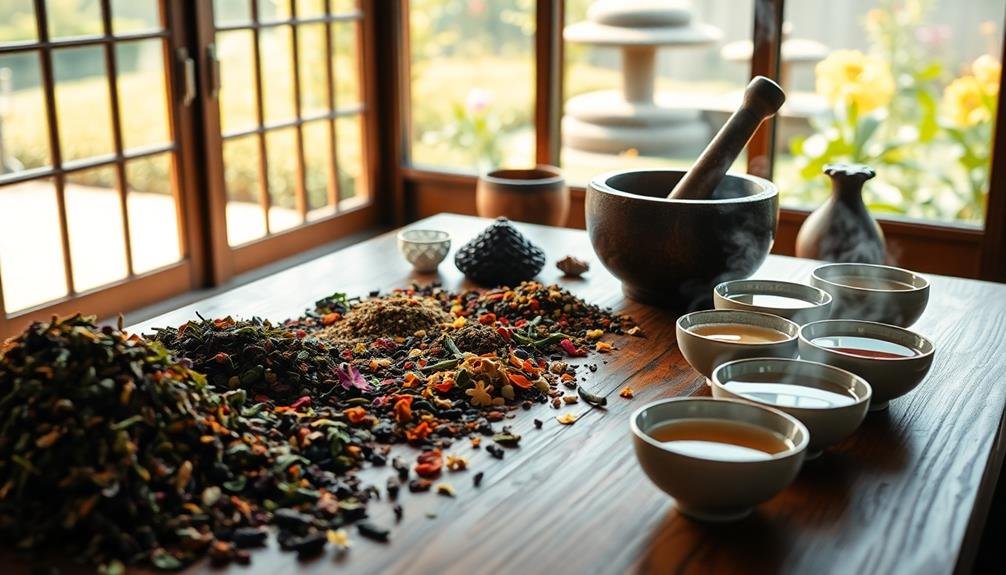
Beyond their delightful flavors, teas offer a wide range of therapeutic benefits. As you explore tea creation, you'll discover how different herbs and botanicals can support your health and well-being.
Green tea, rich in antioxidants, may boost metabolism and promote heart health. Chamomile tea can help calm your nerves and improve sleep quality, while peppermint tea aids digestion and reduces bloating.
In your tea creation classes, you'll learn to harness these therapeutic properties and craft blends tailored to specific needs. You'll explore the science behind each ingredient and understand how they interact to create powerful, healing concoctions.
From immune-boosting blends to stress-relieving infusions, you'll develop the skills to address various health concerns through your custom tea creations.
To make the most of your tea's therapeutic properties:
- Steep your tea for the recommended time to extract ideal benefits
- Experiment with different combinations to find what works best for you
- Consult with a healthcare professional before using teas for medicinal purposes
Seasonal Tea Blending Ideas
Embracing the changing seasons through tea blending offers a delightful way to connect with nature's rhythms. You'll find that each season brings its own unique flavors and ingredients to inspire your tea creations.
In spring, try combining light green teas with fresh herbs like mint or lemon balm. Summer calls for invigorating blends featuring fruity notes—think hibiscus, berries, and citrus peels. As autumn arrives, shift to warming spices like cinnamon, ginger, and clove paired with black teas. Winter's chill invites rich, comforting blends using vanilla, cocoa nibs, and roasted nuts.
To get you started, here's a seasonal tea blending guide:
| Season | Base Tea | Complementary Ingredients |
|---|---|---|
| Spring | Green | Mint, Jasmine, Lemongrass |
| Summer | White | Hibiscus, Peach, Lemon |
| Autumn | Black | Cinnamon, Apple, Clove |
| Winter | Rooibos | Vanilla, Orange, Nutmeg |
| Year-round | Oolong | Ginger, Rose, Lavender |
Remember to experiment with proportions and steep times to achieve your perfect blend. Don't be afraid to mix and match across seasons—your palate is the ultimate guide. By creating seasonal blends, you'll develop a deeper appreciation for tea's versatility and nature's ever-changing bounty.
Tea Tasting Techniques

Now that you've explored seasonal blending, it's time to refine your ability to appreciate tea's nuances. Tea tasting techniques are essential skills for any aspiring tea creator. You'll learn to identify subtle flavors, aromas, and textures that make each tea unique.
Start by examining the dry leaves, noting their appearance and scent. As you steep the tea, observe how the leaves unfurl and release their aroma. When tasting, slurp the tea to aerate it, allowing the flavors to spread across your palate. Pay attention to the tea's body, astringency, and aftertaste.
To enhance your tea tasting experience:
- Use a white cup to accurately assess the tea's color
- Taste different teas side by side for comparison
- Keep a tasting journal to track your observations
Practice describing teas using specific terminology, such as floral, vegetal, or malty. Don't be afraid to trust your senses and develop your own vocabulary.
With time and practice, you'll become adept at discerning the complex profiles of various teas, enabling you to create more sophisticated blends.
Storing and Packaging Homemade Teas
Once you've crafted your perfect tea blend, how do you secure it stays fresh and flavorful? Proper storage is essential. Keep your teas in airtight containers, away from light, heat, and moisture. Glass jars with tight-fitting lids or opaque ceramic containers work well.
Store them in a cool, dark place like a pantry or cupboard.
Label your teas with the blend name and date of creation. This helps you track freshness and rotate your stock. Most teas retain their quality for about six months to a year when stored correctly.
For packaging, consider using resealable foil bags or tea tins. These protect against air and light while maintaining flavor.
If you're gifting your teas, get creative with packaging. Use small cloth bags, decorative tins, or even repurposed containers.
Don't forget to include brewing instructions with your packaged teas. Specify water temperature, steeping time, and any special preparation notes. This guarantees that others can enjoy your blend as intended.
Frequently Asked Questions
Are There Any Age Restrictions for Attending Tea Blending Classes?
You'll find that most tea blending classes don't have age restrictions. They're typically open to all ages. However, it's always best to check with the specific class organizer, as some may have minimum age requirements for safety reasons.
Can I Bring My Own Herbs to Use in the Class?
You're welcome to bring your own herbs, but it's best to check with the instructor first. They'll guarantee your herbs are safe and compatible with the class materials. Don't forget to label them clearly for everyone's safety.
How Long Does a Typical Tea Blending Class Last?
You'll typically spend about two hours in a tea blending class. It's enough time to learn the basics, experiment with different combinations, and create your own unique blends. You'll leave with new skills and custom teas to enjoy.
Are There Certification Programs Available for Tea Blending?
Yes, you'll find certification programs for tea blending available. They're offered by tea academies and culinary schools. You can earn credentials like Certified Tea Blender or Tea Sommelier. These programs typically cover various aspects of tea production and blending techniques.
Do You Offer Private or Group Tea Blending Workshops?
Yes, we offer both private and group tea blending workshops. You'll learn to create custom blends tailored to your taste preferences. Our expert instructors will guide you through the process, whether you're joining solo or with friends.
In Summary
You've now commenced on an exciting journey into the world of tea blending. Armed with knowledge, tools, and creativity, you're ready to craft unique blends that suit your taste and wellness needs. Don't be afraid to experiment with different ingredients and ratios. Remember to store your creations properly and share them with friends and family. As you continue to explore and refine your skills, you'll discover the true art and joy of creating personalized teas.

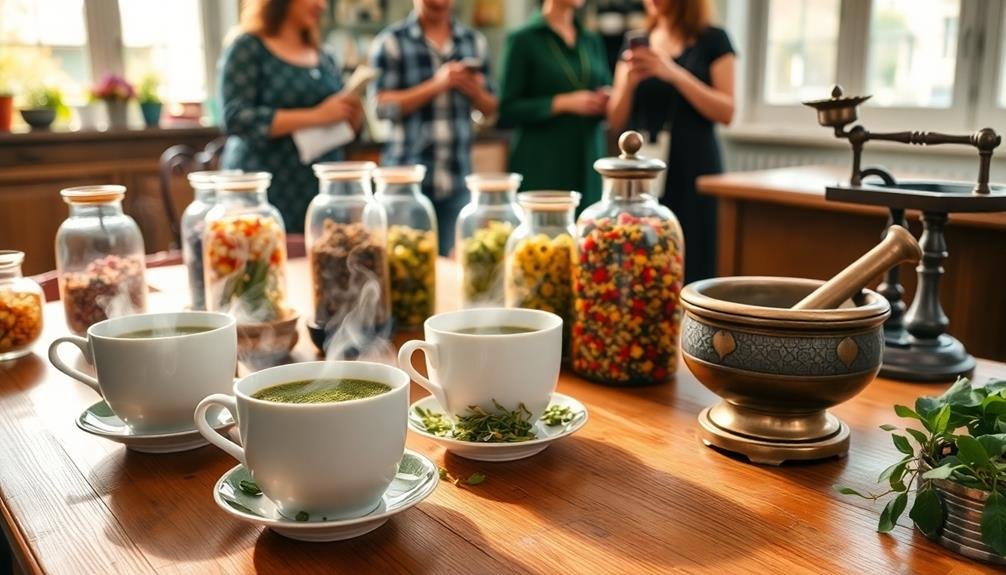
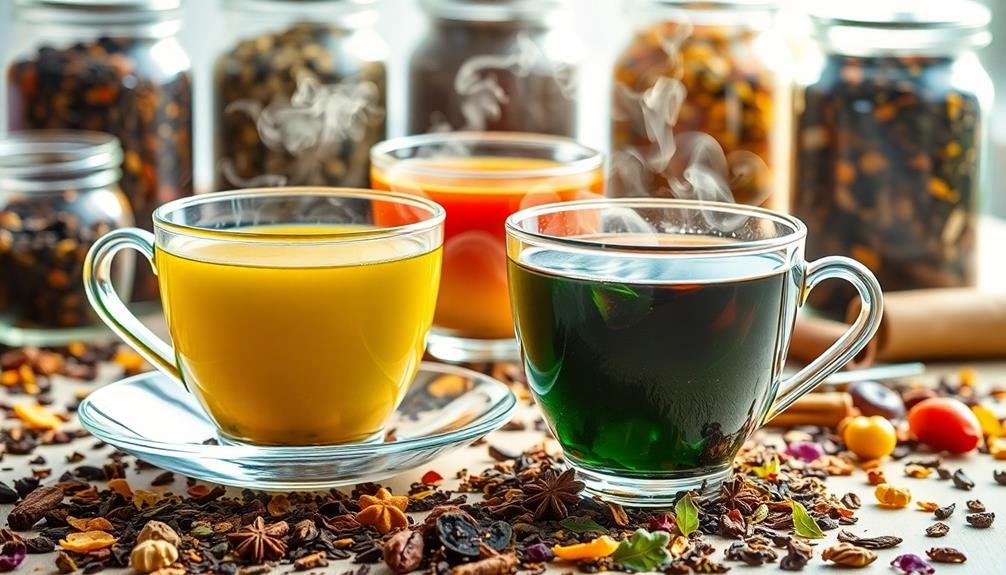
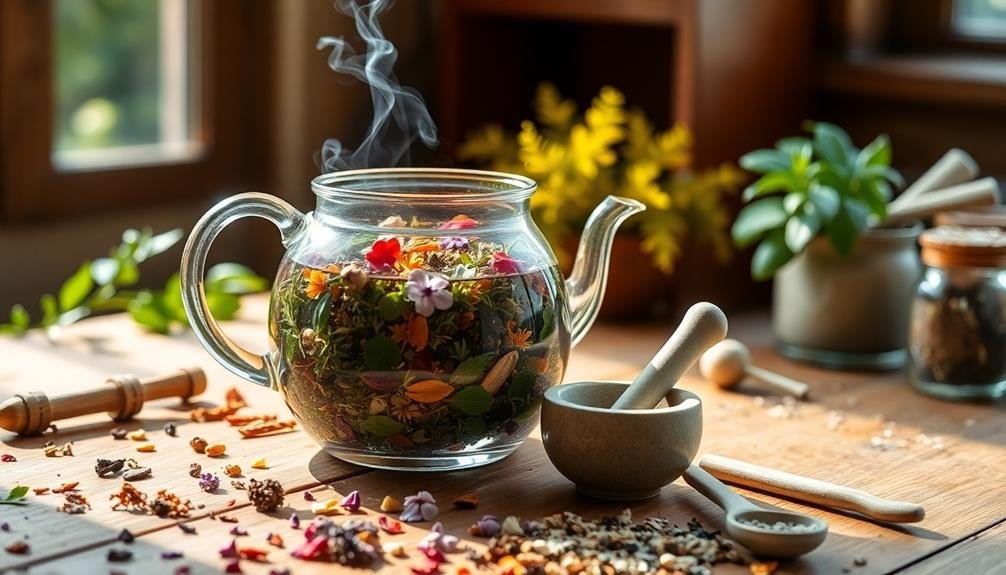
Leave a Reply